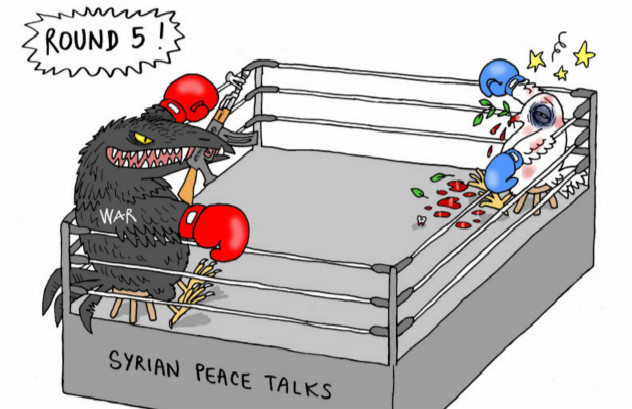Don't cry for profits, corporate America
 |
|
US President Donald Trump attends a meeting at the White House in Washington, US, March 31, 2017. [Photo/Agencies] |
Corporate tax cuts are coming in the United States. While this push pre-dates the presidential election in November, US President Donald Trump's "Make-America-Great-Again" slogan has sealed the deal. Beleaguered US businesses, goes the argument, are being squeezed by confiscatory taxes and onerous regulations-strangling corporate earnings and putting unrelenting pressure on capital spending, job creation and productivity, while sapping America's competitive vitality. Apparently, the time has come to give businesses a break.
But if the problem is so simple, why hasn't this fix already been tried? The answer is surprising.
For starters, it is a real stretch to bemoan the state of corporate earnings in the US. Commerce Department data show that after-tax corporate profits (technically, after-tax profits from current production, adjusted for inventory and depreciation-accounting distortions) stood at a solid 9.7 percent of national income in the third quarter of last year.
While that is down from the 11 percent peak hit in 2012-owing to tepid economic growth, which typically puts pressure on profit margins-it hardly attests to a chronic earnings problem. Far from anemic, the current GDP share of after-tax profits is well above the post-1980 average of 7.6 percent.
Trends in corporate taxes, which stood at just 3.5 percent of national income in the third quarter of last year, support a similar verdict. So, while there may be reason to criticize the structure and complexities of the US corporate tax burden, there is little to suggest that overall corporate taxes are excessive.
Conversely, the share of national income going to labor has been declining. In the third quarter of 2016, worker compensation-wages, salaries, fringe benefits, and other so-called supplements such as social security, pension contributions and medical benefits-stood at 62.6 percent of national income. While that represents a bit of a rebound from the 61.2 percent low recorded in the 2012-14 period, it is 2 percentage points below the post-1980 average of 64.6 percent. In other words, the pendulum of economic returns has swung decisively away from labor toward owners of capital-not exactly a compelling argument in favor of relief for purportedly hard-pressed American businesses.
True, both business investment and employment growth have been glaring weak spots in the current recovery. But there is a distinct possibility that this is due less to onerous taxes and regulatory strangulation, and more to an unprecedented shortfall of aggregate demand.
Economists long ago settled the debate over what drives business capital spending: factors affecting the cost of capital (interest rates, taxes and regulations) or those that influence future demand. The demand-driven models (operating through so-called "accelerator" effects) won hands down.
This is logical. Businesses can be expected to expand capacity and hire workers only if they expect their markets to grow. For the US, that may also be a stretch. Since the first quarter of 2008, inflation-adjusted personal consumption expenditures in the US have grown by just 1.6 percent annually, on average-fully 2 percentage points below the 3.6 percent norm in the 12 preceding years. In fact, the current period is the weakest 35 quarters of real consumption growth in post-World War II history. If past is prologue-as it is for many businesses as they frame their expectations-the focus on tax relief and deregulation could ring hollow, without addressing weak consumer demand.
Trump's narrative of a once-great America that has supposedly lost its competitive edge is at odds with the best available evidence: an annual compendium published by the World Economic Forum, which provides a detailed assessment of 114 individual competitive metrics for some 138 countries.
In the WEF's 2016-17 Global Competitiveness report, the US came in third in terms of overall international competitiveness (behind Switzerland and Singapore)-maintaining pretty much the same position it has held over the past decade. Yes, the US scores poorly on corporate tax rates, regulation, and government bureaucracy; but it more than compensates for those shortcomings with exceedingly high rankings for capacity for innovation (2/138), company spending on research and development (2/138), and availability of scientists and engineers (2/138).
Impressive scores on financial-market development, labor-market efficiency and several aspects of business sophistication are also big pluses for the US' consistently high rankings in the WEF's global tally. In short, the US has hardly lost its competitive edge.
In an ideal world, it would be nice to streamline, simplify, and even reduce tax and regulatory burdens on US businesses. But business is not the weak link in the US economic chain; workers are far more vulnerable. Economic returns have shifted dramatically from the providers of labor to the owners of capital over the past 25 years. That, more than anything, speaks to the need for an urgent reordering of the priorities in the US' national economic policy debate.
The author, a faculty member at Yale University and former Chairman of Morgan Stanley Asia, is the author of Unbalanced: The Codependency of America and China.
Project Syndicate





















